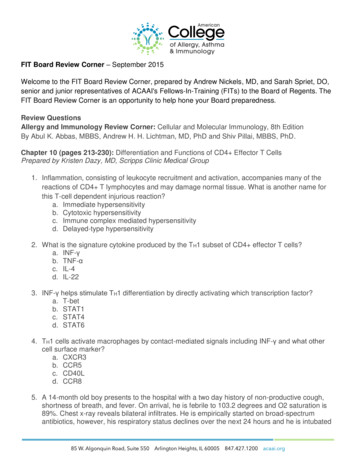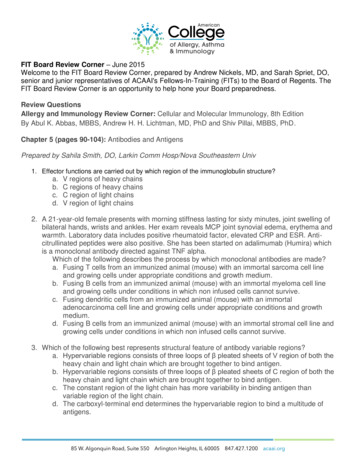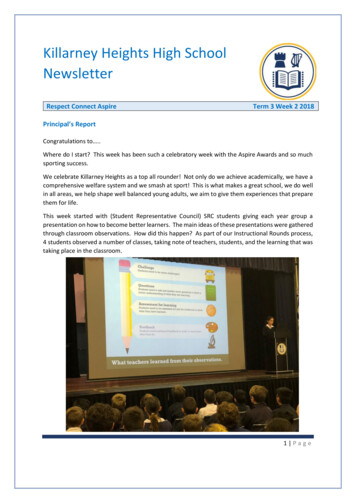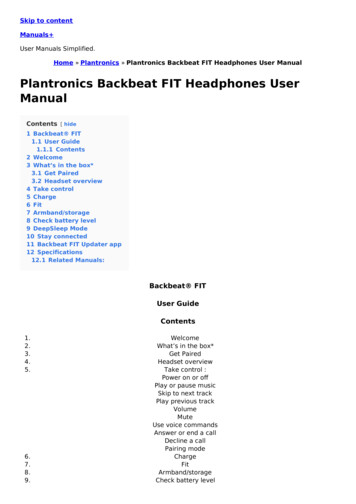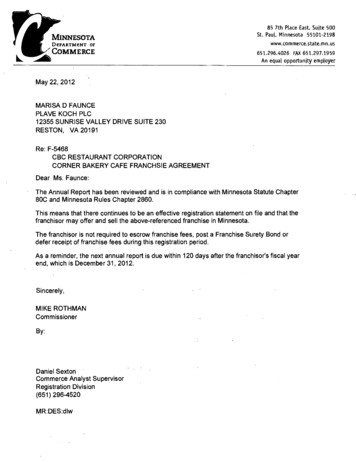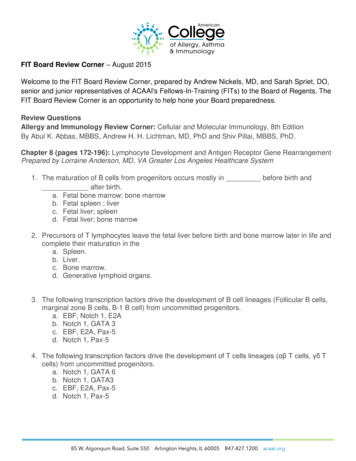
Transcription
FIT Board Review Corner – August 2015Welcome to the FIT Board Review Corner, prepared by Andrew Nickels, MD, and Sarah Spriet, DO,senior and junior representatives of ACAAI's Fellows-In-Training (FITs) to the Board of Regents. TheFIT Board Review Corner is an opportunity to help hone your Board preparedness.Review QuestionsAllergy and Immunology Review Corner: Cellular and Molecular Immunology, 8th EditionBy Abul K. Abbas, MBBS, Andrew H. H. Lichtman, MD, PhD and Shiv Pillai, MBBS, PhD.Chapter 8 (pages 172-196): Lymphocyte Development and Antigen Receptor Gene RearrangementPrepared by Lorraine Anderson, MD, VA Greater Los Angeles Healthcare System1. The maturation of B cells from progenitors occurs mostly in before birth andafter birth.a. Fetal bone marrow; bone marrowb. Fetal spleen ; liverc. Fetal liver; spleend. Fetal liver; bone marrow2. Precursors of T lymphocytes leave the fetal liver before birth and bone marrow later in life andcomplete their maturation in thea. Spleen.b. Liver.c. Bone marrow.d. Generative lymphoid organs.3. The following transcription factors drive the development of B cell lineages (Follicular B cells,marginal zone B cells, B-1 B cell) from uncommitted progenitors.a. EBF, Notch 1, E2Ab. Notch 1, GATA 3c. EBF, E2A, Pax-5d. Notch 1, Pax-54. The following transcription factors drive the development of T cells lineages (αβ T cells, γδ Tcells) from uncommitted progenitors.a. Notch 1, GATA 6b. Notch 1, GATA3c. EBF, E2A, Pax-5d. Notch 1, Pax-5
Page 2 of 95. In T cells IL7 is required for proliferation. Mutations in the common γ chain of the IL-7 receptorcauses an immunodeficiency disorder called X-Linked Severe combined immunodeficiencydisease (X-SCID). This disease is characterized bya. Block in T and B cell development.b. Block in T, NK cell and B cell development.c. Block in T and NK cell development but normal B cell development.d. Block in T, NK cell, B cell and dendritic cell development.6. Lymphocyte development is a stepwise process guided by 2 check points before thelymphocyte can be selected to “mature.” What is the first check point during lymphocytedevelopment?a. Expression of the pre-B/T antigen receptor.b. Positive selection.c. Negative selection.d. Clonal deletion and receptor editing.7. Negative selection is a process important in maintaining central tolerance. Which statementaccurately describes Negative selection?a. A process that selects lymphocytes that weakly recognize self-antigens for apoptosis.b. A process that eliminates or alters developing lymphocytes whose antigen receptorsbind strongly to self-antigens.c. A process that selects lymphocytes that weakly recognize self-antigen for maturation.d. A process that eliminates or alters developing lymphocytes whose antigen receptorsbind weakly to self-antigens.8. Genes that encode antigen receptors of B and T cells are generated by the rearrangement ofthe variable (V) region gene segments with diversity (D) and joining (J) gene segments. Whichstatement accurately identifies the correct gene segment rearrangement?a. The Ig light chain protein (κ or λ) V domain is encoded by the V, D, and J genesegments while the Ig heavy chain protein V domain is encoded by the V and J genesegments.b. The Ig light chain protein (κ or λ) V domain is encoded by the V and D gene segments;while the Ig heavy chain protein V domain is encoded by the V,D, and J gene segments.c. The Ig light chain protein (κ or λ) V domain is encoded by the V and J gene segments;while the Ig heavy chain protein V domain is encoded by the V and J gene segments.d. The Ig light chain protein (κ or λ) V domain is encoded by the V and J gene segments;while the Ig heavy chain protein V domain is encoded by the V,D, and J gene segments.9. Which TCR gene loci has similarities to the Ig heavy chain locus?a. TCR α and TCR β.b. TCR α and TCR γ.c. TCR β and TCR δ.d. TCR β and TCR λ.10. The sequential events during V (D) J recombinationa. Double stranded break (Rag-1, Rag-3), hairpin opening (TdT), end-processing(Artemis), non homologous end joining (Ku70, Ku80, DNA-PK, XRCC4, DNA ligase IV).
Page 3 of 9b. Double stranded break (Rag-1, Rag-2), hairpin opening (Artemis), end-processing(TdT), non homologous end joining (Ku70, Ku80, DNA-PK, XRCC4, DNA ligase IV).c. hairpin opening (Artemis), Double stranded break (Rag-1, Rag-2) end-processing (TdT),non homologous end joining (Ku70, Ku80, DNA-PK, XRCC4, DNA ligase IV).d. non homologous end joining (Ku70, Ku80, DNA-PK, XRCC4, DNA ligase IV), Doublestranded break (Rag-1, Rag-2), hairpin opening (Artemis), end-processing (TdT).11. Which enzyme(s) is (are) responsible for junctional diversity by adding P and N nucleotides?a. Artemis.b. DNA ligase IV.c. Rag 1, Rag 2.d. TdT.e. Ku70, Ku80, DNA-PK.12. The most immature cortical thymocytes are and considered to be a the pro-Tcell stage and express the following protein(s)z:a. Double positive T cells; Artemis.b. Double negative T cells, Rag1 and Rag 2.c. Double positive T cells, Rag 1 and Rag 2.d. Double negative T cells, Artemis.13. Negative selection of T cells occurs in the thymic cortex at the double positive T cell stage andin the thymic medulla at the single positive T cell stage. What mutation results in autoimmunepolyendocrine syndrome?a. Btk.b. Artemis.c. AIRE.d. Rag-1 and Rag2.Answers1. D, page 172.The maturation of B cells from progenitors committed to this lineage occurs mostly in the bonemarrow and before birth in the fetal liver.2. A, page 172.Precursors of T lymphocytes leave the fetal liver before birth and bone marrow later in life andcomplete their maturation in the thymus.3. C, page 173 Figure 8-2.4. B, page 173 Figure 8-2.5. C, page 173.X linked SCID is characterized by a block in T cell and NK cell development with normal B celldevelopment, i.e. T(-)B( )NK(-).
Page 4 of 96. A, page 176.The assembled pre-BCR and pre-TCR complexes provide signals for survival, for proliferation, for thephenomenon of allelic exclusion and for the further development of early B and T lineage cells. Thusexpression of the pre antigen receptor is the first checkpoint during lymphocyte development.7. B, page 176.Negative selection is a process that eliminates or alters developing lymphocytes whose antigenreceptors bind strongly to self-antigens present in generative lymphoid organs. T cells with highaffinity for self-antigens are eliminated by apoptosis a phenomenon known as clonal deletion.Strongly self-reactive immature B cells may be induced to make further Ig gene rearrangements inphenomenon called receptor editing. If editing fails, the self-reactive B cells die, also called clonaldeletion. Negative selection of immature lymphocytes is an important mechanism for maintainingtolerance to many self-antigens; this is also called central tolerance because it develops in the central(generative) lymphoid organs.8. D, page 178 Figure 8-5.The Ig light chain protein (κ or λ) V domain is encoded by the V and J gene segments; while the Igheavy chain protein V domain is encoded by the V,D, and J gene segments9. C, page 177.In the TCR β and δ proteins, the V domain is encoded by the V, D and J gene segments, and in theTCR α or γ proteins the V domain is encoded by the V and J gene segments. Thus the TCR β and δloci also have D segments like the Ig heavy chain locus.10. B, page 182 Figure 8-10.11. D, page 183.The addition of new nucleotides is mediated by the enzyme terminal deoxynucletideyl transferase(TdT)12. B, page 192.The most immature cortical thymocytes are called double negative thymocytes. Rag-1 and Rag-2proteins are first expressed at the double negative stage of T cell development and are required forthe rearrangement of TCR genes.13. C, page 196.In the medulla, medullary thymic epithelia cells express a nuclear protein called AIRE (autoimmuneregulator) that induced the expression of a number of tissue-specific genes in the thymus. The AIREdependent expression in the thymus makes many tissue specific peptides available for presentationto developing T cells, facilitating the deletion (negative selection) of these cells. A mutation in thegene that encodes AIRE results in an autoimmune polyendocrine syndrome.
Page 5 of 9Review QuestionsAllergy and Immunology Review Corner: Cellular and Molecular Immunology, 8th EditionBy Abul K. Abbas, MBBS, Andrew H. H. Lichtman, MD, PhD and Shiv Pillai, MBBS, PhD.Chapter 9 (pages 202-211): Activation of T LymphocytesPrepared by Sarah Spriet, DO, Walter Reed National Military Medical Center1. Which receptor and ligand pair results in costimulation of naïve T cells and the generation ofregulatory T cells?a. CD28 : B7b. CTLA-4 : B7c. ICOS : ICOSLd. PD1 : PDL22. Identify the anti-apoptotic protein which promotes T cell survival.a. Baxb. Bcl-2c. Bimd. Fas3. Identify the correct statement regarding costimulators below.a. Of all potential APCs, macrophages express the highest levels of costimulators and,thus, are the most potent stimulators of naïve T cells.b. One of the major functions of adjuvants in T cell activation is to stimulate the expressionof costimulators on APCs.c. T cells recognize antigen (with or without B7 costimulators), causing expression ofCD40 on T cells.d. Ox40 (CD134) is a TNFR family member expressed on naïve T cells that functions tomaintain cell survival and sustained responses.4. Identify the receptor that has a negative regulatory effect on T cells.a. CD28b. ICOSc. CTLA-4d. CD405. What surface protein binds to and reduces expression of S1PR1 resulting in the retention ofactivated T cells in lymphoid organs?a. CD25b. CD40Lc. CD62Ld. CD69
Page 6 of 96. What immunobiologic agent acts on CD80/CD86 to block costimulation and T cell activation?a. Abataceptb. Adalimumabc. Basiliximabd. Etanercept7. Which of the following chains is unique to the IL-2 receptor?a. αb. βc. γd. δ8. What is the most important cytokine for the maintenance of memory CD4 and CD8 T cells?a. IL-2b. IL-3c. IL-4d. IL-79. What protein chain of the IL-2R is non-functional in X-linked SCID?a. CD25b. CD122c. CD127d. CD13210. Identify the correct statement regarding memory T cells.a. Central memory T cells express CC47 and L-selectin and home mainly to lymph nodes.b. Central memory T cells home to mucosal tissues and produce IFN-γ in response toantigenic stimulation.c. The most reliable phenotype markers for memory T cells appear to be the surfaceexpression of the IL-7 receptor and CD28.d. The maintenance of memory T cells requires cytokines and antigen recognition.Answers1. A, pages 202-204.The proliferation and differentiation of naïve T cells require signals provided by molecules on antigenpresenting cells, called costimulators, in addition to antigen-induced signals. The best characterizedcostimulatory pathway in T cell activation involves the T cell surface receptor CD28, which binds theco-stimulatory molecules B7-1 (CD80) and B7-2 (CD86) expressed on activated APCs. Numerousreceptors homologous to CD28 and their ligands homologous to B7 have been identified, and theseproteins regulate T cell responses both positively and negatively. Binding of ICOS:ICOSL leads to costimulation of effector and regulatory T cells and generation of follicular helper T cells. Whereas,CTLA-4 and PD-1 are inhibitory receptors of the CD28 family. Of the possible answers, only CD28binding to B7 results in co-stimulation of naïve T cells.
Page 7 of 92. B, page 203.Costimulatory signaling via CD28 amplifies signaling pathways that are also induced downstream ofthe T cell receptor and may trigger additional signals that cooperate with TCR-induced signals. PI3kinase is recruited to the cytoplasmic tail of CD28, and this in turn activates the downstream prosurvival kinase Akt as well as ItK and PLCγ, which can trigger calcium signaling. CD28 can alsocontribute to the activation of the JNK MAP kinase via the Rac small G protein and can amplify theactivation of the NF-kB pathway. The net result of these signaling pathways is the increasedexpression of anti-apoptotic proteins such as Bcl-2 and Bcl-XL, which promote survival of T cells;increased metabolic activity of T cells; enhanced proliferation of the T cells; production of cytokinessuch as IL-2; and differentiation of the naïve T cells into effector and memory cells.BH3-only proteins are sensors of cell stress that bind to and influence death effectors and regulators.In lymphocytes, the most important of these sensors is a protein called Bim. Activated Bim binds totwo pro-apoptotic effector proteins of the Bcl-2 family called Bax and Bak, which oligomerize andinsert into the outer mitochondrial membrane, leading to increased permeability.In CD4 T cells, the most important death receptor is Fas and its ligand is FasL. Their bindingactivates a cascade of caspases, which ultimately cause the apoptotic death of the cells. The samepathway of apoptosis may be involved in the elimination of self-reactive B lymphocytes also in theperiphery.3. B, pages 202-205.Many adjuvants are products of microbes, or mimic microbes, and one of their major functions in Tcell activation is to stimulate the expression of costimulators on APCs. Of all potential APCs, maturedendritic cells express the highest levels of costimulators and, as a result, are the most potentstimulators of naïve T cells. T cells recognize antigen (with or without B7 costimulators), causingexpression of CD40L on T cells. Ox40 is a TNFR family member expressed on activated CD4 andCD8 T cells that functions to maintain cell survival and sustained responses.4. C, page 204.CTLA-4 and PD-1 are critical inhibitors of T cells and are sometimes called coinhibitors. Binding of B7to CTLA-4 inhibits the initial activation of T lymphocytes in secondary lymphoid organs. Binding ofPD-L2 to PD-1 inhibits the activation of effector cells, especially in peripheral tissues. CD28 and ICOSare costimulators. CD40 is a member of the TNFR superfamily expressed on B cells, macrophagesand dendritic cells. CD40 has functions in the activation of macrophages in cell-mediated immunityand activation of B cells in humoral immune responses. Activated helper T cells express CD40L,which engages CD40 on the APCs and activates the APCs to make them more potent by enhancingtheir expression of B7 molecules and secretion of cytokines that promote T cell differentiation. Thus,the CD40 pathway indirectly amplifies T cell responses by inducing costimulators on APCs, butCD40L does not itself function as a costimulator for T cells.5. D, page 206.After the initiation of activation by antigen recognition and costimulator binding, there arecharacteristic changes in the expression of various surface molecules in T cells. Within a few hours ofactivation, T cells increase their expression of CD69, a plasma membrane protein. This protein bindsto and reduces surface expression of the sphingosine 1-phosphate receptor S1PR1, a receptor thatmediates the egress of T cells from lymphoid organs.
Page 8 of 9The consequence of decreased S1PR1 expression is that activated T cells are retained in lymphoidorgans long enough to receive the signals that initiate their proliferation and differentiation intoeffector and memory cells. After cell division, CD69 expression decreases, the activated T cells reexpress high levels of S1PR1, and therefore effector and memory cells can exit the lymphoid organs.CD25 is a cytokine receptor that enables activated T cells to respond to the growth-promotingcytokine IL-2. The expression of CD40L enables activated T cells to mediate their key effectorfunctions, which are to help macrophages and B cells. In addition, CD40L on the T cells activatesdendritic cells to become better APCs. During activation, T cells reduce expression of molecules thatbring them to the lymphoid organs such as L-selectin (CD62L) and the chemokine receptor CCR7and increase the expression of the molecules that are involved in their migration to peripheral sites ofinfection and tissue injury.6. A, pages 206, 410, and www.pdr.net.Abatacept (Orencia) is a selective costimulation modulator. It is a fusion protein composed of the Fcregion of human IgG fused to the extracellular domain of CTLA-4. Abatacept binds to the CD80 (B71) and CD86 (B7-2) molecules and prevents the second signal, thereby preventing T cell activation.This medication is currently being used for the treatment of Rheumatoid Arthritis refractive to antiTNF therapy.Adalimumab (Humira) is a fully human anti-TNF-alpha monoclonal antibody. It binds to TNF-alphaand decreases the inflammatory response associated with autoimmune diseases. This medication isapproved for treatment of several conditions including RA, Crohn’s Disease and AnkylosingSpondylitis.Basiliximab (Simulect) is a chimeric mouse-human monoclonal antibody to the α chain (CD25) of theIL-2 receptor of T cells. It is used to prevent rejection in organ transplantation, especially in kidneytransplants.Etanercept (Enbrel) is another TNF antagonist. Its uses include symptoms reduction in patients withRA, JIA, Psoriatic Arthritis, Plaque Psoriasis and Ankylosing Spondylitis.7. A, page 208.Of the three chains, only IL-2α is unique to the IL-2R. IL-2 binds to the alpha chain alone with lowaffinity, and this does not lead to any detectable cytoplasmic signaling or biologic response. The betachain is also part of the IL-15 receptor. The gamma chain is shared by multiple cytokine receptorsinvolving those for IL-4, IL-7, IL-9, IL-15, and IL-21. The IL-2 receptor has no delta chain.8. D, pages 211 and 493.The most important cytokine for the maintenance of memory T cells is IL-7, which also plays a keyrole in early lymphocyte development and in the survival of naïve T cells. Memory CD8 cells alsodepend on the related cytokine IL-15 for their survival. IL-7 and IL-15 induce the expression of antiapoptotic proteins and stimulate low level proliferation, both of which maintain populations of memoryT cells for long periods.
Page 9 of 9IL-2 is involved in the proliferation and differentiation of T cells into effector and memory cells. It alsopromotes regulatory T cell development, survival and function. IL-2 is also involved with theproliferation and activation of NK cells as well as B cell proliferation.IL-3 induces maturation of all hematopoietic lineages.IL-4 acts on B cells, T cells, Macrophages and Mast cells. In regards to T cells, IL-4 is involved in TH2differentiation and proliferation.9. D, pages 208, 444, and 493.X-linked SCID is caused by mutations in the gene encoding the common gamma chain (CD132)which is shared by the receptors for the interleukins IL-2, IL-4, IL-7, IL-9, IL-15 and IL-21. CD25 refersto IL-2R alpha chain, CD122 refers to IL2R beta chain and CD127 refers to the IL7R alpha chain.10. A, page 211.Central memory T cells express CC47 and L-selectin and home mainly to lymph nodes. Effectormemory T cells do not express CCR7 or L-selectin and home to peripheral sites, especially mucosaltissues. On antigenic stimulation, effector memory T cells produce effector cytokines such as IFN-γ orrapidly become cytotoxic, but they do not proliferate much. The most reliable markers for memory Tcells are IL7R and CD27.Maintenance of memory T cells is dependent on cytokines but does notrequire antigen recognition.
FIT Board Review Corner - August 2015 Welcome to the FIT Board Review Corner, prepared by Andrew Nickels, MD, and Sarah Spriet, DO, senior and junior representatives of ACAAI's Fellows-In-Training (FITs) to the Board of Regents. The FIT Board Review Corner is an opportunity to help hone your Board preparedness. Review Questions
